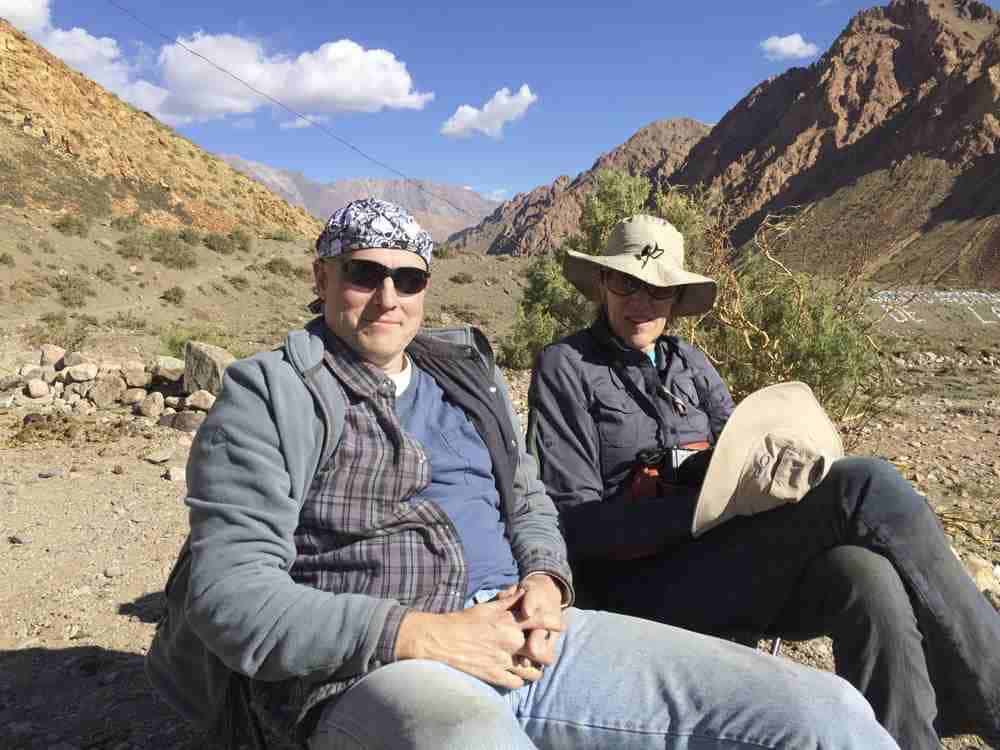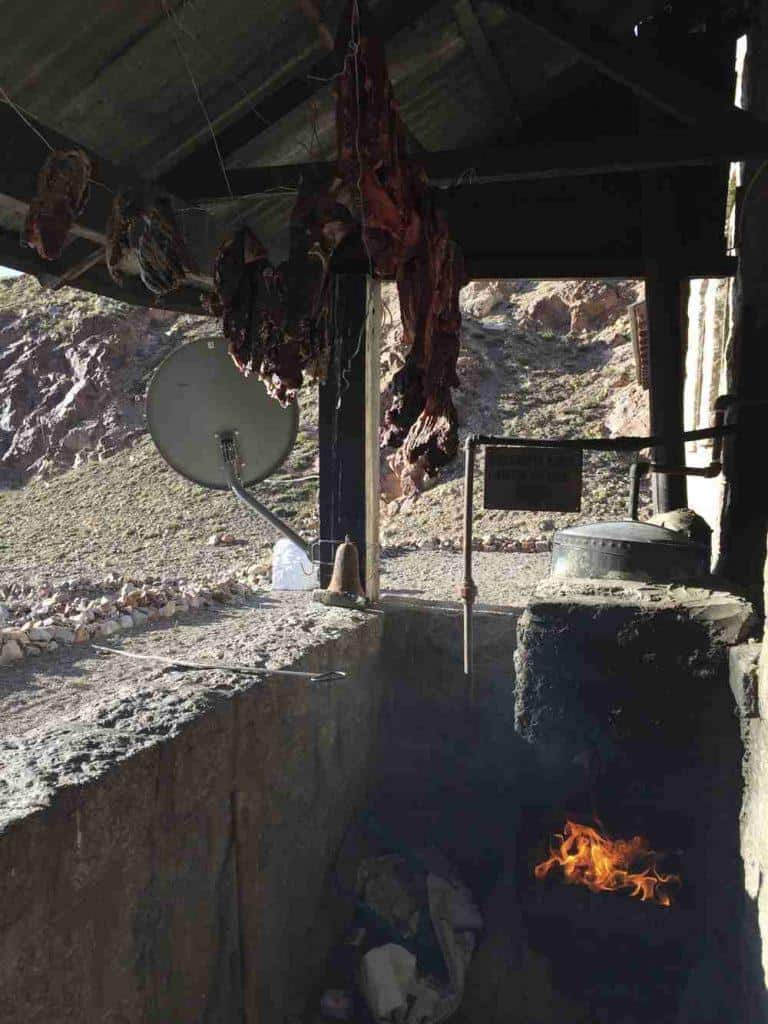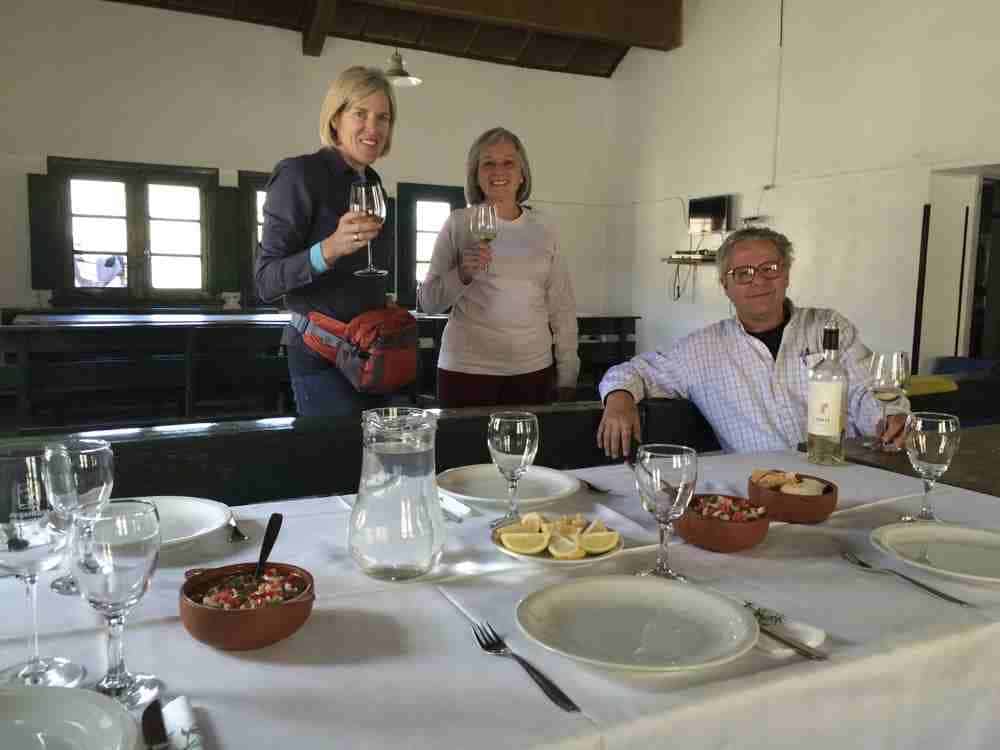Argentine Wines and Homes in a Vineyard
(Plus) Crossing the Andes on Horseback: Part 4 – A Day of Rest in the High Valley
This week’s column tells about our 2nd and 3rd nights crossing the Andes on horseback in January of 2015. Carol and I found ourselves on this trip because my long-time friend Steve Rosberg, owner of the La Morada Vineyard in Mendoza, Argentina, had asked us to come visit and take the ride with him.
Steve and I had been discussing a Joint Venture of some kind for years between ECI and his 1000-acre, mature, and award-winning vineyard as a way to develop affordable vineyard estates for North Americans who wanted the lifestyle but could not come up with the money for a Napa Valley price tag.
 Steve Hosting ECI’s Team for a Steak Dinner on January 15, 2019, to Discuss Final Details of a Joint Venture
Steve Hosting ECI’s Team for a Steak Dinner on January 15, 2019, to Discuss Final Details of a Joint Venture
Steve and I mapped out a plan during the ride. Right now, four years later, I’m back in Argentina crossing the “T’s” and dotting the “I’s” with him along with our operations team and some excited shareholders and clients looking to be first out of the gates in what will be the next exciting ECI community.
If you’d like to get more information about how you can own an income-producing vineyard property in Mendoza, Argentina, reach out here.
Right now, read on for days 3 and 4 of my Andes crossing story.
The Refugio And A Glorious Day In The High Valley
 The Refugio Cruz de la Real – Our Home for Two Nights in the High Valley
The Refugio Cruz de la Real – Our Home for Two Nights in the High Valley
The Refugio Cruz de la Real is an army outpost manned by a garrison of about 6-8 young men in the summertime only. In the winter, the valley is blanketed in many feet of snow and the outpost is abandoned.
Interestingly, a “real” in Argentina is what we call a corral in the U.S. and Canada. The namesake for the refugio is a large “real” used for centuries by the cattle drivers to contain the animals overnight.
 The Ancient Reals (Corrals) Used to Keep Animals Overnight on the Way to Market in Chile
The Ancient Reals (Corrals) Used to Keep Animals Overnight on the Way to Market in Chile
Right beside the ancient “real” now sits an army post, also called a refugio, a “refuge,” as it were. Open only in the summer months, it serves as an army outpost but also as a shelter for passersby like us – not that there are very many.
Rent for the night is about $30 per person, and for that you get a hard cement floor, a picnic table with benches, and a real toilet. Forget the other stuff. Trust me, the toilet is worth an easy $30 after you’ve had your back end hanging out in sub-zero temps with freezing winds whipping by. Oh yes. $30 for an indoor bathroom is a bargain.
 The Luxury of Cement Floors in the Refugio
The Luxury of Cement Floors in the Refugio
Dinner the first night in the refugio was going to be empanadas and pizza, but in the end, I think all Janni made were the empanadas, which she brought out at about 6:00 p.m. Fed and exhausted, we all crashed at about 7:00 p.m.
 Refugio Empanada Dinner Upon Arrival
Refugio Empanada Dinner Upon Arrival
However, my stomach got the better of me and I arose at 8:30 p.m. for more empanadas. Eric, a trail mate, also arrived in the common room for a snack at about the same time. They may have eaten pizza later, but by 9:00 p.m. I was back to bed, burrowed deep in my sleeping bag and fast asleep. So was Carol.
 Carol Fast Asleep, Hat and All
Carol Fast Asleep, Hat and All
The next morning, I woke with the predawn light and made my way outside to explore. The day was breaking behind the mountains, creating some impressive colors in the sky behind the ridge, including a crimson halo around some nearby peaks.
 Dawn Outside the Refugio
Dawn Outside the Refugio
Up the valley to the north, the faces of the volcanoes and high ridges that were hidden by low snow clouds the day before, now shown crystal clear in the morning sun. The cloud crown on the snow-capped volcano indicated continued low pressure, possibly storms later in the day. This was indeed a good day to stay in the valley and explore the tumbled rocks and incredible geology on display.
 The Cloud Crown on the Snow-Capped Volcano Indicating a Low-Pressure System
The Cloud Crown on the Snow-Capped Volcano Indicating a Low-Pressure System
After a great breakfast of eggs, bacon, toast, coffee, and yerba mate, Edgardo and Johnny went to the real, where our horses had spent the night.
 Our Horses in the Real
Our Horses in the Real
They prepared the horses to get us across the stream, now too high to wade downstream. After dropping us on the other side, our gauchos, Edgardo and Johnny, were off to forage far downstream for some dry shrubs to burn in the outdoor fireplace, to heat water for the showers. Apparently, the water heater also creates smoke to dry meats. More on that later.
 Stream Crossing on Horseback to Stay Dry
Stream Crossing on Horseback to Stay Dry
After getting across the stream, we ditched the horses and hiked a few miles to see some lagoons along the base of the ridge that are home to tiny frogs, ducks, and a host of water flowers and grasses. The water is a weird color of blue, and the vivid greens of the grasses and water plants are startling against the rocky backdrop of reds, yellows, and browns of the cliffs and valley floor.


 Vivid Greens in a World of Muted Browns and Greys
Vivid Greens in a World of Muted Browns and Greys
The stark beauty of the valley is also incredible. Stunted plants and trees 100+ years old are no bigger than a small bush in most parts of the world. Yet, life hangs on anywhere it can and adapts to the circumstances. The mineral-rich rocks also streak with color, albeit much less vividly than the lagoon.
 100+ Year-Old Tree Hanging Onto Life One Cold Year After Another
100+ Year-Old Tree Hanging Onto Life One Cold Year After Another
On the way back to camp, I once again tried my hand at panning for either gold, copper, or lapis lazuli in these ore-laden mountains. No big find. Oh well. The fun is in the panning and the hope, or at least it should be.
 Panning in the Copper-Rich Andes
Panning in the Copper-Rich Andes
After a few pans, it was time to head back to camp and enjoy a leisurely afternoon talking with our fellow travelers in the warm sun. While we were sitting outside, the Argentinian flag broke free of its pole and began to blow away. It was quickly rescued and passed along to the army folks where it was re-hoisted to fly again over the valley.
But while the flag was down, Eric and I took turns holding it up for photos. Eric also took a picture of me wearing a “do-rag.” It was his pre-trip present to me. I especially appreciated the skulls-and-crossbones pattern.
 The Loose Argentinian Flag Rescued from the Wind
The Loose Argentinian Flag Rescued from the Wind

Mike in his “Do-Rag” Relaxing with Carol
The refugio is an interesting place. A refuge and outpost at the edge of civilization. In fact, really, an outpost outside civilization. Only open for about 10 weeks per year, the soldiers manning the place arrive in January and depart in March. Most of the rest of the year, this place is under tons of snow.
 The Water-Heating Wood Stove Also Drying Meat. Plus, a Satellite Dish for the Soldiers’ TV
The Water-Heating Wood Stove Also Drying Meat. Plus, a Satellite Dish for the Soldiers’ TV
This picture is fun because we have an ancient wood stove, burning brush actually, smoking meats turning to jerky, along with a satellite dish to bring in the latest movies for the army guys. I could not get the solar cells on the roof in the same shot, but the juxtaposition of the various elements is fantastic.
Water comes from the stream via three-inch black conduit pipes running into the refugio. Auxiliary power at night is from a small generator hookup that would make OSHA and UL cringe. I stayed back. But it works.
After a restful day, Janni prepared a fine dinner. Well rested and refreshed from a day out of the saddle, we were relaxing in the relative warmth of the refugio. The table is set and merrymaking begins.
Dinner begins early and then ends early. Tomorrow, we ride at sunrise to cross the river when it is at its lowest. Overnight, the temperature plunges in the valley and on the mountains. The melting of the glaciers and snow ceases. The river running down the center of the valley slows. The fords are safe to cross. Early morning is the only time you can. We ride at dawn.
 Relaxing Before a Great Dinner with Carol, Cora, and Steve in the Refugio
Relaxing Before a Great Dinner with Carol, Cora, and Steve in the Refugio
In next week’s column, I relate the climb up out of the valley to the base of the next high mountain pass and the border into Chile. I may do this excursion again, and if you’d like to ride along next time, let me know.
E-mail me at: mcobb@ecidevelopment.com
I’ll add your name to a growing list of folks ready for a fun adventure.
By the way, I just arrived in Mendoza again yesterday (January 15th, 2019) and am happy to see my friend Steve again. He says he isn’t going to ride across the Andes again, but that he’ll have the La Morada guest house ready, stocked with wine, and the parrillada going when we get done.
 The Treats Awaiting Guests at the La Morada Clubhouse
The Treats Awaiting Guests at the La Morada Clubhouse
Think about a visit, maybe for a ride, or maybe for some R&R, fine wine, and fun times. This place is amazing. Have a great week.
For more information please go HERE
 Michael K. Cobb is the CEO and co-founder of ECI Developments which has properties throughout Latin America. He speaks all over the world on international real estate and is a board member of the National Association of Realtors.
Michael K. Cobb is the CEO and co-founder of ECI Developments which has properties throughout Latin America. He speaks all over the world on international real estate and is a board member of the National Association of Realtors.
Like Our Articles?
Then make sure to check out our Bookstore... we have titles packed full of premium offshore intel. Instant Download - Print off for your private library before the government demands we take these down!





